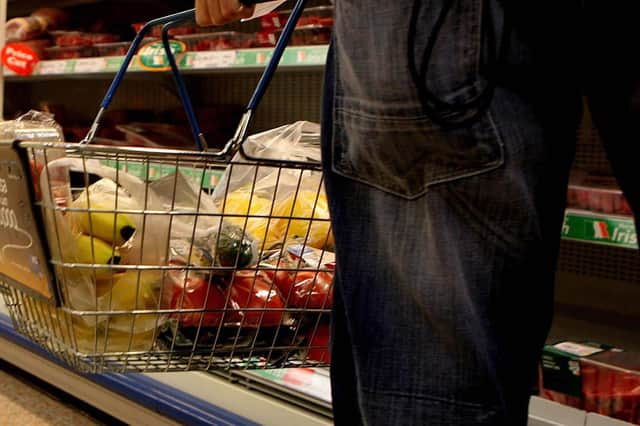Economist: How the Northern Ireland Protocol could raise the cost of your shopping basket


The Northern Ireland Protocol encourages NI retailers to shift from relatively efficient UK-wide supply chains to relatively higher cost ones that operate through to Republic of Ireland (RoI) or the rest of the EU.
Even on moderate assumptions (‘central scenarios’) this could add several £100 millions annually to NI’s grocery bills.
Advertisement
Hide AdAdvertisement
Hide AdSome argue that one way to mitigate the frictions imposed by the protocol on NI businesses is to replace UK-wide supply chains with ones relating to the RoI or EU. It has even been argued that the apparently very large increase in cross-border trade during 2021, partly a result of that switch in supply chains, proves the protocol does indeed represent the best of both worlds.


The ‘best of both worlds’ claims are unlikely to be correct given the extent to which the protocol is likely to have raised costs to NI businesses and households in terms of buying in goods coming from Great Britain.
In 2019 (most recent figures) the total value of goods brought into NI from GB was about £11 billion. Hence, even if the protocol adds ‘only’ a few % extra to such costs that amounts to hundreds of millions of pounds of extra costs each year.
It is very likely that supply chain adjustment to the protocol, replacing GB suppliers with RoI or EU26 ones, will really lead to a large increase in prices being paid by NI consumers for their groceries.
Advertisement
Hide AdAdvertisement
Hide AdWhat is the evidence for this? First of all, it is very clear that retail food prices are much higher in RoI than in NI. Food items matter a great deal in this context since we know this is where the greatest frictions relating to the protocol tend to be (even given grace periods and stand still periods).
In a comparison of 30 identical goods sold in Tesco stores North and South in 2014 RoI prices were 20% higher (Irish Times 25 August 25 2014, ‘North and South: A tale of two grocery bills’).
In 2020, using Eurostat figures RoI food retail prices were 34% higher than the UK average [Note 1].
Secondly, some of that price difference is probably attributable to the difference between RoI and UK food retail logistics of supply chains [Note 2]. This point has been confirmed to me by an expert within the road haulage sector. Why would RoI supply chains be higher cost [Note 3]? Firstly, because of the smaller market size (5 million compared to about 68 million) hence implying less economies of scale and, secondly, because transport distances tend to be longer (RoI to continental Europe as compared to GB to NI).
Advertisement
Hide AdAdvertisement
Hide AdGiven the range of factors which could impact on prices as a “central scenario” we assume that half of the food retail price differential is attributable to supply chain differences: hence a 17% higher price level. In 2020 NI’s spending on food groceries was about £2,500m [Note 4].
If we further assume that eventually half of the NI grocery market will shift from UK supply chains to RoI/EU ones, then the extra annual spending required given the higher prices associated with the RoI/EU supply chains could be several £100 million annually [Note 5]: about £200m.
It is also worth stressing that higher prices to consumers in the supermarkets and grocery shops is only one of economic impacts of the trade frictions imposed by the Protocol and hence only part of the total cost to NI output or GDP as, for example, indicated in the recent study by the economists at the Fraser of Allander Institute [Note 6]. Currently the high real cost of the Protocol is being disguised by a combination of grace periods and heavy spending by the UK government on business support schemes. Such mitigations may cease to operate in the relatively near future and then where will we be [Note 7]”.
• Dr Esmond Birnie is senior economist at Ulster University Business School
Notes:
Advertisement
Hide AdAdvertisement
Hide Ad1. Eurostat December 2021, “File: Price level indices for food, beverages and tobacco 2020 (EU=100) Update”. The index number for food prices was 119.5 in RoI but 89.5 for the UK. Note, Eurostat did not provide a regional breakdown within the UK. Given the penetration into the NI market of the GB multiplies since the 1990s it is probably reasonable to assume that pre-Protocol the NI price level was broadly similar to the UK average.
2. Some but probably not all. Some of the food retail differential could be attributable to higher wages or rental charges in RoI retail or perhaps even monopoly profits in a less competitive market. The RoI is also a higher nominal GDP per person economy than the UK (including NI) and in general, internationally, as nominal income per person is higher, as measured at market exchange rates, so are prices. It does seem unlikely that tax differences are a major explanation. Although the RoI standard VAT rate is a little higher than the UK rate, most food items are zero-rated in both countries.
3. G. Gudgin and H. Western 2022, “What impact will the Protocol have on the Northern Ireland economy?”, Briefings for Britain, argue that the use of RoI-based supply chains is very likely to lead to higher costs to NI consumers.
4. In 2020 average weekly spending on food and non alcoholic drinks was £ 65.1 (ONS 16 March 2021, “Family Spending: Expenditure by regions”). There were 728,000 households. Total annual food retail spend: £65.1 X 52 X 728,000= £2464.4m.
5. i.e. £2,464.4m X 0.5 X 0.17 = £209m
Advertisement
Hide AdAdvertisement
Hide Ad6. G. Duparc-Portier and G. Figus November 2021, “The impact of the new Northern Ireland Protocol: Can Northern Ireland enjoy the best of both worlds?”, Regional Studies.
7. Some commentary from a industry, logistics expert suggests that when the UK government’s online assistance Movement Assistance Scheme finishes at the end of this year its replacement the Digital Assistance Scheme will not be as useful for most businesses